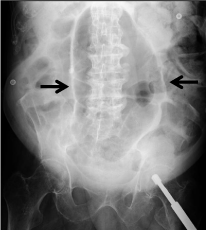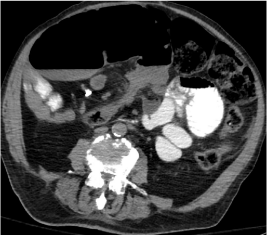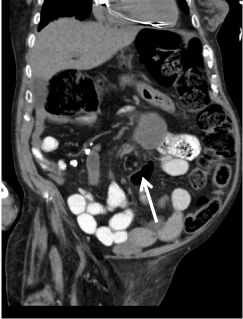Research Article
Surgical Treatment of Cecal Volvulus
Nir Horesh1*, Roy Nadler1, Ron Pery1, Aviad Gravetz1, Michal Marianne Amitai2, Danny Rosin1, Mordechai Gutman1, Oded Zmora1 and Eyal Klang2
1Department of Surgery and Transplantation, Chaim Sheba Medical Center, Israel
2Department of Radiology, Chaim Sheba Medical Center, Israel
*Corresponding author: Nir Horesh, Department of Surgery and Transplantations B, Sheba Medical Center, Tel Hashomer, Ramat Gan, 52621, Israel
Published: 07 Mar, 2017
Cite this article as: Horesh N, Nadler R, Pery R, Gravetz A,
Amitai MM, Rosin D. Surgical Treatment
of Cecal Volvulus. Clin Surg. 2017; 2:
1346.
Abstract
Purpose: Right sided intestinal volvulus is considerably rare and requires high clinical suspicion in
diagnosis and prompt surgical intervention. Several surgical procedures have been employed for
the treatment of this condition, and there is no wide agreement on the most appropriate technique.
The aim of this study is describe our experience with volvulus of the cecum and the outcome of
different management strategies.
Methods: A cohort retrospective study was conducted, including all patients diagnosed with cecal
volvulus between January 2012 and January 2016.
Results: Nine patients were diagnosed and treated for cecal volvulus. 3 patients (33.3%) underwent
a failed attempt for endoscopic decompression. 8 patients (88.8%) were operated urgently and one
patient with spontaneous resolution at initial presentation was operated subsequently. Five patients
(55.5%) underwent right colonic resection and 3 patients (33.3%) underwent cecopexy. One patient
underwent a tube cecostomy. Post-operative complications occurred in 5 patients (55.5%) and 3
patients died (33.3%) in the post-operative period, all considered high risk patients prior to surgery.
Conclusion: Cecal volvulus is a clinical emergency requiring immediate intervention. Endoscopic
intervention in cecal volvulus should not be attempted. Selection of the surgical procedure should
rely on the clinical presentation of the patient and surgical judgment.
Keywords: Cecal volvulus; Surgical treatment; Computerized tomography
Introduction
Cecal volvulus is the rotation or torsion of a flexible cecum and ascending colon, frequently
progressing to bowel obstruction, ischemia, necrosis, and perforation unless promptly treated
[1]. It is an uncommon entity, with a relatively low incidence, causing approximately 1% of all
colonic obstructions, but is associated with significant morbidity and mortality [2]. Volvulus of the right colon is considered less common than volvulus of the left colon, but several reports found
similar occurrence rates, with correlation to certain age groups [3-5]. Colonic volvulus should be suspected with a clinical picture of abdominal pain, bloating and constipation and plain abdominal
radiography suggesting the diagnosis. Computerized tomography of the abdomen and pelvis is
highly accurate in the diagnosis of both sigmoid’ transverse colon and cecal volvulus [6]. Despite similarities in epidemiology, clinical presentation and diagnostic measures, the surgical treatment
of colonic volvulus differs greatly between right and left sided volvulus, not only in timing of surgical
intervention but also in possible surgical procedures.
This series retrospectively reviews cases of cecal volvulus in a large tertiary medical center in
recent years, and focuses on the possible surgical treatment options.
Patients and Methods
Patients with cecal volvulus were retrospectively identified from a prospective database initiated
in January 2012. Over 4 years, nine patients with cecal volvulus were found and their charts were
reviewed for demographics, clinical presentation, imaging reports, surgical treatment, length of stay
and post-operative follow-up.
The study has been approved by the local IRB committee.
Results
Nine patients with cecal volvulus were identified over a period of 4 years, between January 2012 and December 2015, including 3 males and 6 females. Age
varied widely with a mean of 54.2 (range 18-93) years. Average
Body mass index was 20.4 (range 17.1-24.3) with 4 patients (44.4%)
with an underweight (18.5 and below) body mass index. 7 patients
out of 9 (77.7%) had history of prior open abdominal surgery, with
repeated cesarean section and exploratory laparotomies being the
most common surgical procedures. Prior medical history varied with
5 patients (55.5%) presenting with cecal volvulus without any chronic
or significant medical history, and 4 patients (44.5%) presenting
with severe co-morbidities including neurological conditions such
as Alzheimer's disease, dementia and cerebral palsy. The differences
between the patients was seen also in the pre-operative ASA score
that averaged at 2.77 (range 1-4) with 4 patients having score of ASA
4.
All patients presented with complaints of abdominal bloating,
constipation and discomfort. In 8 out of 9 patients (88.8%) cecal
volvulus was suspected based on clinical presentation and plain
abdominal radiography, and all patients underwent computerized
tomography to confirm the diagnosis (Figures 1-3).
Three patients (33.3%) underwent an attempt of endoscopic
colonic decompression. None of these attempts succeeded and all
three patients underwent surgery. All three patients underwent
colonic resection with an end ileostomy due to signs of significant
bowel ischemia and two out of these three patients died from postoperative
complications.
All patients underwent surgery due to cecal volvulus. 8 out of 9
patients (88.9%) underwent an emergent open surgery and one patient
underwent elective laparoscopic surgery, following spontaneous
resolution of the volvulus with significant reduction in abdominal
distention and passage of bowel movements. Despite spontaneous
resolution, elective surgery was deemed necessary due to the high risk
of recurrence and associated morbidity, and the patient was operated
a few weeks following resolution.
The surgical procedure varied according to the patients' age and
comorbidities. Table 1 outlines the different surgical procedures performed, along with the patient age and the surgical outcome.
Selection of procedure type was correlated with the functional and
clinical status of the patient. Resection with ileostomy was performed
in high risk patients with significant comorbidities. Resection with
anastomosis and cecopexy were performed in fit patients able to
tolerate the surgery and the possible adverse surgical outcomes.
Length of stay varied and averaged at 16.4 days following surgery
(range 3-56) but with high variability difference between fit patients
and patients with significant comorbidities.
Overall morbidity and mortality rate was high, with 5 out of 9
patients (55.5%) presenting with post-operative complications. In
three patients (33.3%) post-operative complications resulted in
mortality within the same admission, from multi-organ failure.
Table 1
Figure 1
Figure 1
Supine abdominal XR of a 94 years old male. A highly distended
large bowel loop is seen in the mid abdomen. The rest of the large bowel is
also distended and filled with feces.
Figure 2
Figure 2
Axial CT image– The distended cecum is located in the mid-upper
right abdomen. Arrow points to a long narrow bowel loop that exits the
cecum, consistent with the “bird’s beak” sign.
Figure 3
Discussion
Colonic volvulus is an uncommon cause of colonic bowel
obstruction, estimated to cause 3.4% of all colonic obstructions [7],
though incidence is higher in certain areas as the middle east and
Africa [8]. Cecal volvulus is less common than sigmoid volvulus, and
is managed almost exclusively with surgery [3]. Despite similarities
in pathophysiological features and diagnostic methods [9], sigmoid
volvulus can be managed initially with decompressive endoscopy.
The same therapeutic strategy in cecal volvulus has high failure rates
with elevated risk for colonic perforation, prompting emergency
surgical treatment to prevent bowel ischemia and necrosis [3,10,11].
In our series all attempted decompressive colonoscopies failed and
surgery may have been delayed despite being inevitable.
The indication for surgical intervention in cecal volvulus is well
established. However, the recommended surgical procedure for cecal
volvulus is still controversial. Several procedures were suggested
for this rare entity, from bowel diversion including decompressive
cecostomy to cecal fixation and right colectomy, which is mandatory
in cases of intestinal ischemia. Tube cecostomy was popular up to the
1970's and the 1980's [6,12-14] when studies demonstrated promising
results with a fixating cecopexy compared with tube cecostomy,
mainly due high rates of morbidity and mortality associated with
cecostomy, and higher recurrence rate. Some early reports in small
number of patients suggested a combination of cecopexy with
cecostomy [15]. Abandonment of cecostomy was first suggested
by Rabinovici [13] who demonstrated increased rates recurrence,
complications and mortality with cecostomy when compared with
detorsion and resection. Additional studies confirmed this surgical
approach [16-18] emphasizing the need for resection in patients with
significant bowel ischemia and sign of bowel gangrene.
The introduction of laparoscopy had a fairly negligible effect
on the surgical treatment of cecal volvulus. Halabi et al [3] recently
published a comprehensive review of patients with colonic volvulus
over two decades and found that only less than 4% of patients were
treated laparoscopically, most commonly in younger patients with
less co-morbidities. The use of laparoscopy in the treatment of cecal
volvulus is mentioned in the literature mainly as case reports and no
comparative studies exist [2,19].
The retrospective nature of this study and the relatively small
number of patients with this rare condition are obvious limitations of
this study. The selection of surgical procedure was based on surgeon
preference and clinical judgment, which limits firm conclusions
regarding the proper selection of surgery. Despite these limitations, our series has a relatively large number of patients diagnosed with an
uncommon condition over a period of four recent years, and confirms
prior data regarding the high morbidity and mortality of cecal
volvulus. It also demonstrates that initiating therapeutic intervention
with decompressive colonoscopy should be avoided. The wide range
of surgical procedures used for cecal volvulus suggests that the
selection of the procedure should be tailored to the patients' clinical
status. Although the more aggressive surgical approach was used in
high risk patients, mortality in these patients remains high. Larger
studies, perhaps multi-institutional, with a predefined treatment
paradigm, are required to define the best surgical procedure for cecal
volvulus.
Conclusion
Cecal volvulus is a clinical emergency condition requiring immediate intervention. Endoscopic intervention in cecal volvulus should not be attempted. Selection of the surgical procedure should rely on the clinical presentation of the patient. Large-scale studies are required to define the best surgical procedure for this condition.
References
- Consorti ET, Liu TH. Diagnosis and treatment of caecal volvulus. Postgrad Med J. 2005; 81: 772-776.
- Baldarelli M, De Sanctis A, Sarnari J, Nisi M, Rimini M, Guerrieri M. Laparoscopic cecopexy for cecal volvulus after laparoscopy. Case report and a review of the literature. Minerva chir. 2007; 62: 201-204.
- Halabi WJ, Jafari MD, Kang CY, Nguyen VQ, Carmichael JC, Mills S, et al. Colonic volvulus in the United States: trends, outcomes, and predictors of mortality. Ann surg. 2014; 259: 293-301.
- Ballantyne GH, Brandner MD, Beart RW, Jr., Ilstrup DM. Volvulus of the colon. Incidence and mortality. Ann surg. 1985; 202: 83-92.
- Ballantyne GH, Brandner MD, Beart RW, Jr., Ilstrup DM. Volvulus of the colon. Incidence and mortality. Ann surg. 1985; 202: 83-92.
- Habre J, Sautot-Vial N, Marcotte C, Benchimol D. Caecal volvulus. American journal of surgery. 2008;196(5):e48-9.
- Pahlman L, Enblad P, Rudberg C, Krog M. Volvulus of the colon. A review of 93 cases and current aspects of treatment. Acta Chir Scand. 1989; 155: 53-56.
- Oncu M, Piskin B, Calik A, Yandi M, Alhan E. Volvulus of the sigmoid colon. South African journal of surgery Suid-Afrikaanse tydskrif vir chirurgie. 1991;29(2):48-9.
- Delabrousse E, Sarlieve P, Sailley N, Aubry S, Kastler BA. Cecal volvulus: CT findings and correlation with pathophysiology. Emerg radiol. 2007; 14: 411-415.
- Lee SY, Bhaduri M. Cecal volvulus. CMAJ : Canadian Medical Association journal = journal de l'Association medicale canadienne. 2013;185: 684.
- Madiba TE, Thomson SR. The management of cecal volvulus. Dis Colon Rectum. 2002; 45: 264-267.
- O'Mara CS, Wilson THJSGL, Stonesifer GL, Cameron JL. Cecal volvulus: analysis of 50 patients with long-term follow-up. Ann surg. 1979; 189: 724- 731.
- Rabinovici R, Simansky DA, Kaplan O, Mavor E, Manny J. Cecal volvulus. Dis Colon Rectum. 1990; 33: 765-769.
- Wright TP, Max MH. Cecal volvulus: review of 12 cases. South Med J. 1988; 81: 1233-1235.
- Andersson A, Bergdahl L, Linden W. Volvulus of the cecum. Ann surg. 1975; 181: 876-880.
- Gupta S, Gupta SK. Acute caecal volvulus: report of 22 cases and review of literature. Ital J Gastroenterol. 1993; 25: 380-384.
- Ostergaard E, Halvorsen JF. Volvulus of the caecum. An evaluation of various surgical procedures. Acta Chir Scand. 1990; 156: 629-631.
- Yang SH, Lin JK, Lee RC, Li AF. Cecal volvulus: report of seven cases and literature review. Zhonghua Yi Xue Za Zhi (Taipei). 2000; 63: 482-486.
- Shoop SA, Sackier JM. Laparoscopic cecopexy for cecal volvulus. Case report and a review of the literature. Surg endosc. 1993; 7: 450-454.




